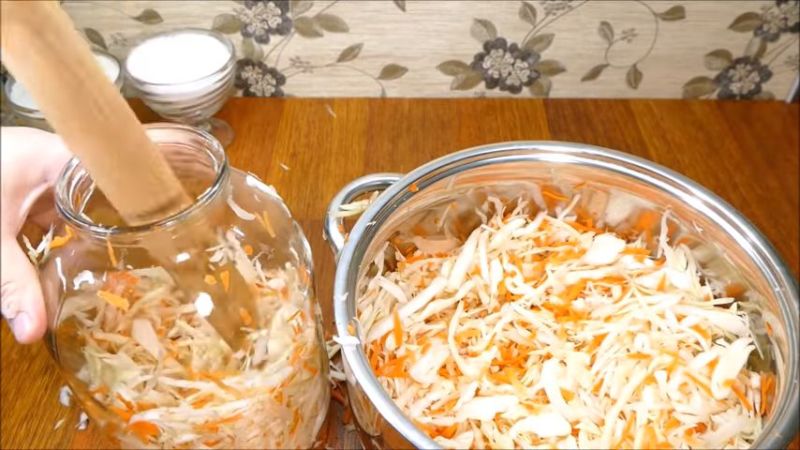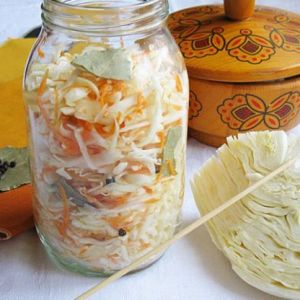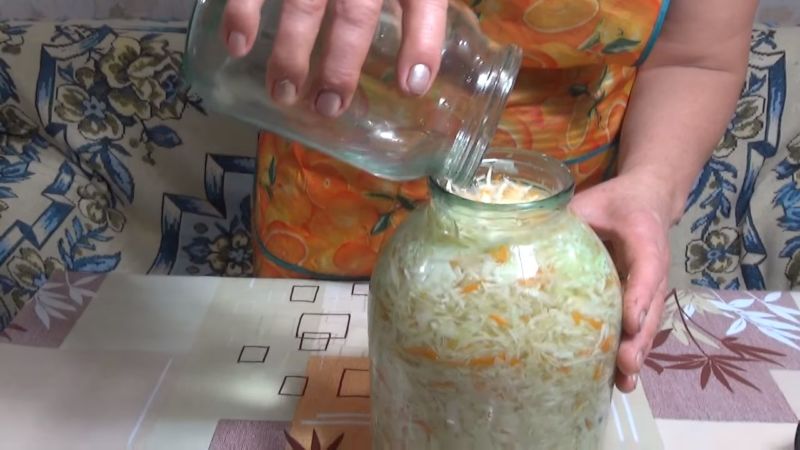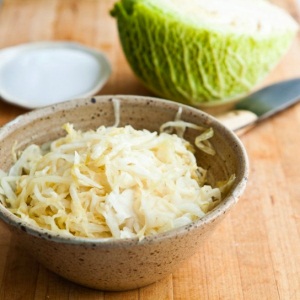Cooking time for a delicious snack: how much cabbage ferments at room temperature and how to determine readiness
Harvested for future use, properly preserved sauerkraut will decorate not only the everyday, but also the festive table. It is served as an independent dish, used for making salads, cabbage soup, soups, bigus, pie fillings.
Let's figure out how much cabbage ferments at room temperature, how to choose the right variety, determine its readiness and keep it for a long time.
The content of the article
How many days to ferment cabbage at home
Pickling is one of the most common ways to harvest cabbage for the winter.... DIY cooked sauerkraut it turns out tasty and healthy. This harvesting method has a small drawback - cabbage is prepared for several days.

The fermentation period depends on several factors.:
- cabbage varieties;
- quantity salt;
- temperature conditions.
Mid-season and late-season varieties are best suited for harvesting for the winter.... They have harder and more juicy heads of cabbage; when fermented, they release a lot of juice. They contain more sugar, which contributes to the fermentation process. The best mid-season varieties and hybrids for harvesting: Gift, Slava, Jubilee F1, Belorusskaya, Dobrovodskaya. Late-ripening varieties - Snow White, Amager, Türkis, Geneva F1, Moscow late.
The taste of the finished dish and its shelf life depend on the amount of salt.... The optimal dosage for pickling is 2% of the cabbage weight. That is, for 10 kg, you need to use 200 g of salt.
The fermentation process proceeds best at room temperature from +18 to 22 ° С... Vigorous fermentation takes place within 5-6 days. At this temperature, vitamin C is retained in the product as much as possible and microbial processes are suppressed due to the formation of acid. After 5-6 days, the container with the finished product is moved to a cool place to slow down the fermentation process.
It is believed that the most delicious snack is obtained at a temperature of +21 ° С... On the fifth day, an optimal ratio of acid and sugar is formed in it, it acquires a salty-wine taste. Further fermentation gives the product a sour-salty taste.
Higher or lower temperatures will negatively affect the product or spoil it... At higher fermentation, cabbage will take 4-5 days, but the taste, color and quality of the finished product will be significantly inferior. Temperatures below + 18 ° С slow down the fermentation process in the snack: it lasts from 1 to 2 months.
How to understand that cabbage is already fermented
 Readiness fermented product is defined quite simply.
Readiness fermented product is defined quite simply.
When the surface of the snack stops producing gases and foam, and the brine becomes light, the product is ready. It tastes salty and sour. The cabbage itself should crunch.
If a small amount of a crispy snack is left at room temperature without brine for 3 hours, and after that it will not lose its crunch, then the product is completely ready.
The readiness of the snack is indicated by a decrease in its volume... So, for example, 12 kg of fresh cabbage makes about 10 kg of sauerkraut.
Monitor product readiness and timing... But at the same time it is important to take into account the amount of sauerkraut. If in a large saucepan, the snack will be ready in about 5-6 days. In a 3-liter can, the process will be 2 times faster.When the allotted time has passed, the product is tasted to make sure it is ready.
General algorithm for fermenting cabbage at room temperature
So that the maximum amount of nutrients is preserved in cabbage, it must be fermented correctly.
Choosing cabbage
For pickling, choose heads of white cabbage of mid-ripening and late-ripening varieties.
Heads of cabbage of early varieties are not suitable for picklingas they are low in sugar and have too delicate leaves. When fermented, the product will turn out to be soft and tasteless.
Choose large white forksbecause they contain more sugar, which affects the fermentation process.
The head of cabbage should be dense. The tighter it is, the better the sauerkraut will crunch.
It should taste sweet, without bitterness, juicy and crunchy.... The tastier the fresh cabbage, the tastier the final product will be.
Council. When choosing cabbage in late autumn, make sure that the cabbages are not frozen.
Optimal fermentation time
Sour cabbage in autumn and winter... Mid-season varieties are processed in autumn. The process begins in September, the finished product must be stored in a cool place.
Late varieties start to ferment 2-3 months after harvest - in November, December... During the laying period, sugar accumulates in the heads of cabbage, they become more juicy. If you prepare late varieties earlier, the fermented product will turn out to be bitter, with an unpleasant odor.

Choice of containers
Ideal for fermentation is considered wooden barrel... It should be oak, birch or lime. A spruce barrel is pre-prepared. It is poured with cold water for 25 days, the water is changed every 5 days. The procedure removes resin and tannins from wood.
Alternative to wooden containers - glass jars... Cabbage is fermented in 3-liter jars, where the fermentation process takes place. After its completion, the banks are immediately put away for storage, without transferring the finished product to another container.
Ceramic dishes are suitable for fermentation... Ferment a snack in enamel buckets and pans. The dishes must be free of chips and damage so that the lactic acid released during fermentation does not react with the metal.
Steel and aluminum containers are not suitable for fermentation... Lactic acid in such dishes reacts with metal. In this case, harmful substances are released, and the workpiece acquires an unpleasant taste.
The use of plastic containers for fermentation is a controversial issue... Only food grade plastic is suitable for fermentation. Poor quality dishes contain harmful chemical compounds, so the sauerkraut will taste unpleasant and absorb the smell of the dishes.
Cooking cabbage
Heads of cabbage selected for pickling are cleaned of the top green leaves, remove 2-3 top sheets. Then washed under running water and dried with a paper towel.
Heads of cabbage are cut into 2-4 parts and chopped with a special shredder or knife... The chopped vegetable is placed in a prepared container. Each layer of cabbage is salted - 20 g of coarse salt per 1 kg of cabbage.
Council. Do not use purchased cabbage stump in the harvest, as it accumulates most of the nitrates. Iodized salt must not be used for fermentation.
The cabbage mass is lightly tamped until juice appears... The container is not filled to the top, leaving a place so that the juice that stands out during fermentation does not flow out.
Add to the cabbage to taste carrots, beets, berries, fruits and spices: bay leaves, allspice, dill seeds, hot peppers, caraway seeds, anise, etc.

Oppression
When the container is full, cover the mass on top with a plate of a smaller diameter... Oppression is installed on it (a can of water or a stone) so that the cabbage is always completely covered with juice.
Council. Do not use metal objects as oppression or wrap them in a plastic bag so that the metal does not come into contact with the brine.
Sourdough time
The container with the workpiece is removed to a warm place (the optimum temperature is from +18 to 22 ° С). Make sure that the product is not exposed to direct sunlight.
The first signs of fermentation - this is the appearance of gas bubbles and foam on the surface, which must be removed. Twice a day, the workpiece is pierced with a wooden skewer to the bottom to release the accumulated gases.
If you do not release bitterness and do not remove the foam, then the fermented product will turn out to be bitter... When the foam ceases to stand out, the fermentation process slows down, which means the product is ready.
Possible problems
If during the first day a little juice is released, water is added to the workpieceso that the crushed mass is completely covered.
The bitter taste of the snack indicates that the preparation did not remove the green leaves or remove the foam from the fermented product.
 If the finished snack is soft and does not crunch, it means that there is little salt in it.... An excess of carrots can also soften the cabbage. Lack of salt or using too light pressure will make the cabbage too tough.
If the finished snack is soft and does not crunch, it means that there is little salt in it.... An excess of carrots can also soften the cabbage. Lack of salt or using too light pressure will make the cabbage too tough.
The appearance of mucus on cabbage indicates that the temperature regime has been violated during fermentation, iodized salt was used, a lot of carrots were added, or there are chemicals in the cabbage. You cannot eat such a snack in its natural form, but it is suitable for preparing hot dishes.
At low temperatures, a film may form on the surface of the workpiece... The upper layer of the product is removed, the plate and the oppression are washed.
When mold appears on the surface discard the top layer of cabbage. Mold will not appear if horseradish leaves are placed on top.
Where and how to store ready-made cabbage
Ready cabbage is placed in a cellar or basement, refrigerator or on a glazed balcony... It is stored in the dishes in which it was cooked, or laid out in glass jars.
Optimum storage temperature for sauerkraut - from 0 to + 2 ° С. At higher acidity, the product loses its elasticity.
Shelf life in barrels at optimum temperature is 8 months, in glass jars - 6 months.
Conclusion
Pickling is one of the most popular ways to harvest cabbage for the winter. Sauerkraut is used as an independent product and as an ingredient for various dishes.
To make it tasty and healthy, to be preserved for a long time, the technology of preparation and storage of the product is observed. Use only white cabbage of mid and late ripening varieties, add the right amount of salt, observe the temperature regime during fermentation and storage.